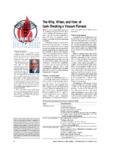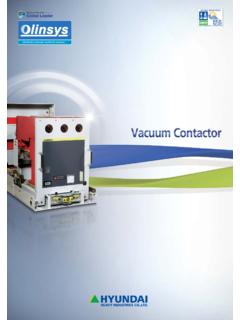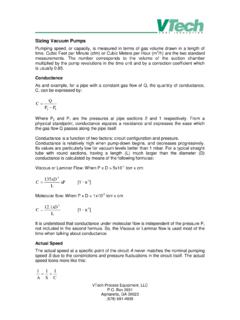Transcription of VACUUM TRUCKS - Reliant Holdings Ltd.- Home
1 Uncontrolled copy if printed. Reliant Holdings LTD AND ITS AFFILIATES Printed on: 30 January 2017 6:55 PM Valid on day of printing only. 2010 Reliant Holdings LTD AND ITS AFFILIATES Safety Management System Doc No: SOP-56 Initial Issue Date 1-20-2018 Revision Date: Initial Version VACUUM TRUCKS Revision No. 0 Next Revision Date: 1-20-2018 Preparation: Safety Mgr Authority: CEO Issuing Dept: Safety Page: Page 1 of 4 Purpose During VACUUM truck operations, workers are at risk of being exposed to toxic gases, flammable materials and other various hazards. This procedure will address proper and safe VACUUM truck operations. Scope When work is performed on a non-owned or operated site, the operator s program shall take precedence, however, this document covers Reliant Holdings LTD AND ITS AFFILIATES employees and contractors and shall be used on owned premises, or when an operator s program doesn t exist or is less stringent.
2 Employees will be aware of provisions of site specific contingency/emergency plans by either Reliant Holdings LTD AND ITS AFFILIATES or of a facility owner. Safe Work Procedures Safe work procedures for VACUUM truck operations must address the potential for chemical reactions and the potential release of toxic gas or fumes. They must also take into account the variety of fluids or substances that VACUUM TRUCKS typically carry. Before starting any VACUUM truck operations Reliant Holdings LTD AND ITS AFFILIATES shall make sure that VACUUM truck owners and operators, as well as facility personnel are aware of the following: The numerous potential hazards associated with VACUUM truck operations in petroleum facilities including but not limited to: sources of ignition, flammable atmospheres, potential hazards associated with the surrounding area, toxic vapors and their PEL's and STEL's additional hazards such as slips and falls, spills and releases, fires and explosions and accidents within the facility or on the highway The evacuation and rescue procedures in the event of a toxic gas leak Ensure that air quality monitoring at the work site is continuous at such locations as the discharge area of the VACUUM truck venting hose Ensure that first aid is readily available on site in the event of exposure to toxic gas Consult the manufacturer's instructions to confirm that the VACUUM equipment is designed for the particular transfer operation Uncontrolled copy if printed.
3 Reliant Holdings LTD AND ITS AFFILIATES Printed on: 30 January 2017 6:55 PM Valid on day of printing only. 2010 Reliant Holdings LTD AND ITS AFFILIATES Safety Management System Doc No: SOP-56 Initial Issue Date 1-20-2018 Revision Date: Initial Version VACUUM TRUCKS Revision No. 0 Next Revision Date: 1-20-2018 Preparation: Safety Mgr Authority: CEO Issuing Dept: Safety Page: Page 2 of 4 Ensure that all equipment including tank and VACUUM TRUCKS , and pumping equipment is in safe working condition. Ensure that the tank interior, filter baghouse, and cyclone separators are clean and free of any substances that may react with the liquids to be vacuumed or transferred Before beginning operations, VACUUM truck operators shall obtain any required permits and inspect VACUUM TRUCKS , equipment, and loading/off-loading sites to assure safe operations Under normal conditions, the absence of oxygen minimizes the risk of ignition in a VACUUM truck .
4 However, operating rotary lobe blowers and VACUUM pumps at high speeds creates high air movement and high VACUUM levels, resulting in high discharge air temperatures and high discharge vapor concentrations that can present potentially ignitable conditions. Atmospheric Testing The areas where VACUUM TRUCKS will operate must be free of hydrocarbon vapors in the flammable range. The areas where the VACUUM truck operator and others work without respirators must also be at or below air contaminant PEL's/STEL's. If there is any question whether the area is vapor or toxic gas free, atmospheric testing shall be performed by a qualified person using properly calibrated and adjusted detectors. Testing shall be conducted prior to starting any operations, and if necessary, during operations, including but not limited to the following: when operations in the area are subject to change such as automatic pump start-up or product receipt into, or transfer out of, a tank located in the vicinity of the transfer operations when off-loading when atmospheric conditions change such as wind direction when an emergency situation, such as product release, occurs in within the facility that may affect atmospheric conditions in the transfer area To prevent exposure to toxic gases during transfer operations.
5 Never transfer fluids from one truck to another unless it has been established that no chemical reaction will occur position TRUCKS to minimize exposure to any discharged gases and fumes ensure that discharge lines are long enough and large enough for safe operation position vent lines away from workers and workstations, including control panels, valve handles, gauges, shut-offs, and hose attachment points - if possible, use a vertical exhaust stack to divert exhaust gases away from workers and ignition sources. check air monitoring equipment during operations to confirm that venting is proceeding safely monitor the following: o tank level indicators to avoid overfilling o tank pressure gauges to avoid over-pressurizing receiving tanks or creating excessive VACUUM in supply tanks Uncontrolled copy if printed. Reliant Holdings LTD AND ITS AFFILIATES Printed on: 30 January 2017 6:55 PM Valid on day of printing only.
6 2010 Reliant Holdings LTD AND ITS AFFILIATES Safety Management System Doc No: SOP-56 Initial Issue Date 1-20-2018 Revision Date: Initial Version VACUUM TRUCKS Revision No. 0 Next Revision Date: 1-20-2018 Preparation: Safety Mgr Authority: CEO Issuing Dept: Safety Page: Page 3 of 4 o tank temperature gauges to help identify possible chemical reactions minimize the air introduced into the system when pressure loading or unloading - submerge the suction line in liquid, or reduce the VACUUM pump speed when skimming or nearing the end of a load maintain a log of transported fluids and any potential residue use gravity loading and unloading whenever possible use a vapor recovery system when available to avoid venting tanks directly to the atmosphere Hoses VACUUM hose constructed of conductive material or thick walled hose with imbedded conductive wiring shall be used when transferring flammable and combustible liquids when the potential for a flammable atmosphere exists in the area of operations.
7 Conductive hose shall provide suitable electrical conductance less than or equal to 1 mega ohm per 100 feet (as determined by the hose manufacturer). Thin walled metallic spiral-wound conductive hoses should not be used because of the potential for electrical discharge through the thin plastic that covers the metal spiral. Bonding and Grounding The complete VACUUM transfer system needs to be bonded so that there is a continuous conductive path from the VACUUM truck through the hose and nozzle to the tank or source container and grounded to dissipate stray currents to earth (ground). Prior to starting transfer operations, VACUUM truck need to be grounded directly to the earth or bonded to another object that is inherently grounded (due to proper contact with the earth) such as a large storage tank or underground piping. A safe and proper ground to earth may be achieved by connecting to any properly grounded object including but not limited to any one or more of the following examples: a metal frame of a building, tank, or equipment that is grounded an existing facility grounding system such as that installed at a loading rack fire hydrants metal light posts, or underground metal piping with at least 10' of contact with earth a corrosion free metal ground rod of suitable length and diameter (approximately 9' long and 5/8-in.)
8 Diameter), driven 8' into the earth (or to the water table, if less) Venting A number of methods can be used by VACUUM truck operators to safely vent VACUUM pump exhaust vapors, including but not limited to the following: operators can prevent dieseling by locating the VACUUM truck upwind of vapor sources and by extending the VACUUM pump discharge away from the diesel engine air intake vapors may be returned to the source container using conductive and closed connections vapors may be vented into the atmosphere to a safe location using a safety venturi Uncontrolled copy if printed. Reliant Holdings LTD AND ITS AFFILIATES Printed on: 30 January 2017 6:55 PM Valid on day of printing only. 2010 Reliant Holdings LTD AND ITS AFFILIATES Safety Management System Doc No: SOP-56 Initial Issue Date 1-20-2018 Revision Date: Initial Version VACUUM TRUCKS Revision No.
9 0 Next Revision Date: 1-20-2018 Preparation: Safety Mgr Authority: CEO Issuing Dept: Safety Page: Page 4 of 4 VACUUM truck operators may provide vertical exhaust stacks extending approximately 12' above the VACUUM truck (or higher if necessary) to dissipate the vapors before they reach ignition sources or other potential hazards and personnel VACUUM truck operators may attach a length of exhaust hose to the VACUUM exhaust that is long enough to reach an area that is free from potential hazards, sources of ignition, and personnel - the hose should be preferably extended 50' downwind of the truck and away from the source of the liquids Training VACUUM truck operators shall be trained and properly licensed in accordance with applicable regulations. VACUUM truck personnel working in petroleum facilities shall be trained in: the safe operation of the VACUUM equipment and be familiar hazards of the petroleum products, byproducts, wastes and materials being transferred aware of relevant government and facility safety procedures and emergency response requirements MSDS of the substances being vacuumed or transferred appropriate PPE the requirement that all personnel shall leave the VACUUM truck cab during loading and off-loading operations the requirement that when transferring flammable liquids or hazardous materials, VACUUM truck operators shall remain positioned between the VACUUM truck and the source or receiving tank, vessel.
10 Or container and within 25' of the VACUUM truck throughout the duration the requirement that VACUUM truck operators shall monitor the transfer operation and be ready to quickly close the product valve and stop the pump in the event of a blocked line or release of material through a broken hose or connection the knowledge that smoking, or any other source of ignition, shall not be permitted within at least 100' (depending on local procedures and atmospheric conditions) of the truck , the discharge of the VACUUM pump, or any other vapor source the requirement that VACUUM TRUCKS shall not enter into a tank dike area until such areas have been checked/monitored and rendered safe VACUUM TRUCKS cargo tanks shall be depressurized the effect of speeds, turns and the changing center of gravity maintaining proper distances when operating VACUUM TRUCKS inside facilities with restricted clearances








